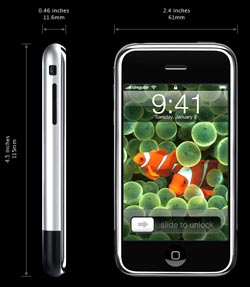It’ll do, in a pinch.
Tuesday, January 9th, 2007
 Those of you know know Sammy and me know that we are the last of our generation to be without a cell phone. I’ve long bemoaned the idiocy of the user interfaces (I hate to glorify them by even using that term) and the entire user experience seemed like one big compromise.
Those of you know know Sammy and me know that we are the last of our generation to be without a cell phone. I’ve long bemoaned the idiocy of the user interfaces (I hate to glorify them by even using that term) and the entire user experience seemed like one big compromise.
And don’t even get me started on the changes for the worse in social behavior that rampant cell phone use has engendered.
All that said, come June, we’ll be gesturing and pinching and poking and rotating and widgeting and googling and rocking and syncing and presence-ing and photo-ing with the best of them, and we’ll do it using a UI as familiar to me as the one I live with every day—Mac OS X.
Yeah, I was impressed. It was a big wow, indeed. And I can now see how all of Apple’s hardware smarts have come together with all of their clever plans for resolution-independent UI, javascript widgets made easy, Core Image, Core Animation, and all kinds of other object-oriented goodness.
Design pundits prattle on about it being the “little things” that make a difference. Here are just three of those little things, probably each involving a huge effort to get right in practice:
- iPhone’s accelerometer detects when you rotate the device from portrait to landscape, then automatically changes the contents of the display, so you immediately see the entire width of a web page or a photo in its proper landscape aspect ratio.
- The proximity sensor detects when you lift iPhone to your ear and immediately turns off the display to save power and prevent inadvertent touches until iPhone is moved away.
- An ambient light sensor automatically adjusts the display’s brightness to the appropriate level for the current ambient light, thereby enhancing the user experience and saving power at the same time.
The end result hangs together so thoughtfully that I just want to smile at the very thought of it. This is design done well, indeed.
UPDATE: As I say in the comments below, if the phone isn’t open to the vast army of salivating Mac developers, it becomes way less attractive to me, too…but as of Wednesday, we really don’t know much about what’s under the hood. Hmm.
UPDATE II: As a non-cell-user, one thing I didn’t think of (and perhaps wouldn’t miss) is tactile feedback. Folks who live their lives surreptitiously poking out messages and changing the configs while their phones remain pocketed in meetings may well notice. And no one (to my knowledge) asked Jobs and company the apparently important question: does it vibrate?

